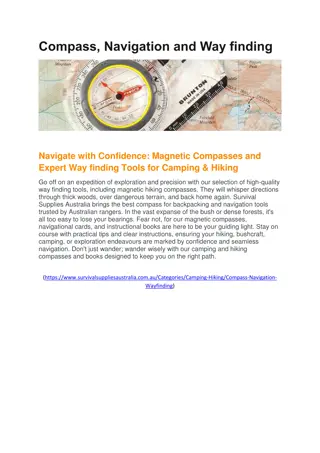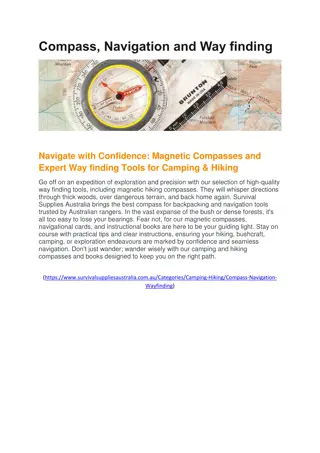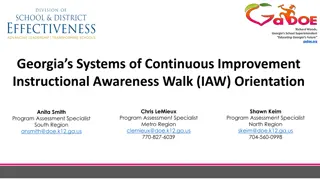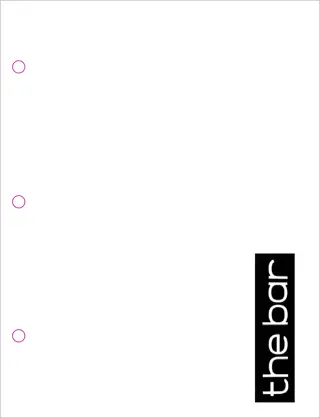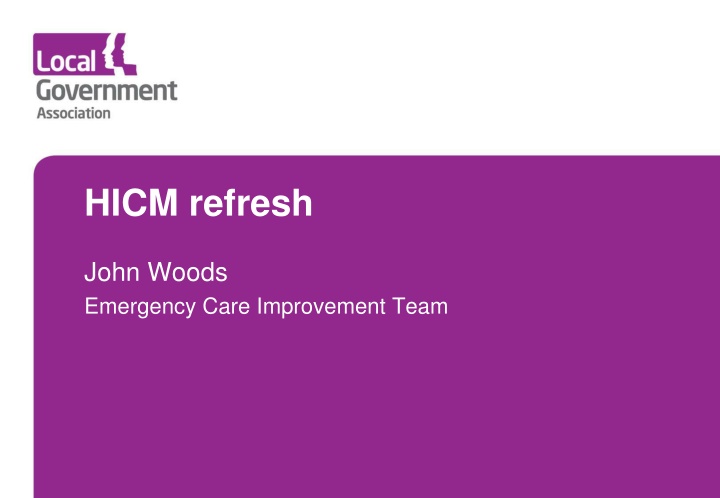
Improving Emergency Care: Insights from HICM Workshops
Gain valuable insights from the HICM refresh conducted by John Woods Emergency Care Improvement Team. Discover key areas for improvement and the strengths of the HICM model as reflected in workshop gatherings and questionnaires. Explore opportunities to enhance emergency care systems and communication. Contact Anna Jennings for more information on the changes implemented by December 2018.
Download Presentation

Please find below an Image/Link to download the presentation.
The content on the website is provided AS IS for your information and personal use only. It may not be sold, licensed, or shared on other websites without obtaining consent from the author. If you encounter any issues during the download, it is possible that the publisher has removed the file from their server.
You are allowed to download the files provided on this website for personal or commercial use, subject to the condition that they are used lawfully. All files are the property of their respective owners.
The content on the website is provided AS IS for your information and personal use only. It may not be sold, licensed, or shared on other websites without obtaining consent from the author.
E N D
Presentation Transcript
HICM refresh John Woods Emergency Care Improvement Team
Nine regional HICM workshop events, gathering reflections of over 550 colleagues from across health and social care Online questionnaire BCF quarterly reporting data: Q2 17/18- Q2 18/19 Work of partner organisations, e.g. ECIST, Hospital to Home New sector research and guidance: Newton Europe intensive diagnostics, CQC local system reviews, NAO health and social care interface, NHSI guide to reducing long hospital stays, quick guides & other materials supporting specific HICs
HICM strengths Overall, workshops and the questionnaire show the HICM is positively received by systems Perceived as a useful tool to support improvement and for bringing systems together, as well as sharing good practice Areas have made steady progress in BCF reporting, with most changes now established in most systems. A positive whole system approach Allows you to network and share good practice/lessons learned; helps to connect you with other systems which are more mature An overall umbrella to see which parts of the system may need focus What we heard Helpful to focus minds The HICM has improved system-working and communication
Key areas for improvement Workshops and questionnaire show areas want more clarity and guidance around the HICM, while ensuring it better allows for local variance and flexibility Strong appetite in workshops and questionnaire to extend the focus of the HICM beyond DTOC to consider wider system partners and admission avoidance. This sits well with broader sector trends toward a person-centric and whole system approach (e.g. as used in the recent CQC local system reviews) Popular demand across workshops and questionnaires to expand scope of the model to include behaviours and enablers which underpin managing transfers of care. This is supported by a large body of research which draws out the importance of strong system leadership and positive working cultures (e.g. Newton Europe diagnostic reviews, NAO health and social care interface) According to workshop participants, change 5 is the most difficult, and there is the most confusion about change 7. BCF reporting and questionnaire responses show areas struggling most with changes 5, 6 and 7 Consideration required of support offer and relaunch to help areas engage with the HICM well: real variance between systems use of the HICM expressed in workshops, consolidated by BCF narrative reporting support needs.
Change by change 6 December 2018 Contact: anna.jennings@local.gov.uk
Change 1: early discharge planning Very few comments about this change in workshops: lack of strong feelings, mandate to keep largely as is In questionnaire, this change was given notably low scores for straightforwardness of local implementation and implementation being effective in driving local improvement. In workshops, some felt this change should focus also on length of stay Suggestion made in questionnaire for wider stakeholder involvement, e.g. housing and home improvement Red bag scheme currently not mentioned explicitly in change/maturity criteria and reported separately to BCF, but given as a good practice example and is part of this change
Change 2: systems to monitor patient flow One of the most successful changes One of the most common workshop answers for most impactful change BCF reporting shows this is currently the second-most established change in systems; one of two changes where planned targets are most often met; and a change where areas have made above-average progress in the last year However, not yet any systems ranking themselves as exemplary in this area A sizable minority felt this change has unclear criteria Questionnaire respondents requested clearer language and more specific detail about what good looks like Suggestion made in workshops to consolidate this change by reducing the number of overlapping sub-categories Better draw out the importance of matching capacity to demand (maturity classification sub- category): separate change? Newton Europe reviews have highlighted the importance of having a single view of the truth and shared understanding of data. Need to ensure data drives improvement by measuring the right things and sharing real time data with the right people (including partners) include in criteria? Any further comments or suggestions?
Change 3: multi-disciplinary/multi-agency discharge teams, including the voluntary and community sector One of the most successful changes Scored second-most positively in questionnaire across a range of criteria The most frequent workshop answer for most impactful change BCF reporting shows this is currently the most established change in systems and one of two changes where planned targets are most often met However, this is the change where areas have made the least progress in the past year (roughly a quarter of areas have progressed by one maturity level) More guidance requested in workshops around inclusion of VCSEs and GPs. Suggestion could also broaden to housing where appropriate A number of areas suggested this change be expanded to a broader MDT culture of collaborative and integrated working beyond discharge (already included in good practice but not explicit in change criteria). CQC local system reviews highlighted good practice in wrap-around care of those at high risk of emergency admission and virtual wards
Change 4: home first/discharge to assess Second-most common answer in workshops for the most impactful change in improving patient flow, and perceived as an easier change to implement Questionnaire respondents were most positive about this, particularly agreeing that its purpose is clear and that the actions focus on the right things However, areas have made below average progress with this change in the last year: BCF reporting cited concerns with community/domiciliary care capacity and lack of staff confidence/risk aversion Workshops participants requested greater clarification around this change, pointing to the varied interpretations of discharge to assess between and among systems Concern about whether this is working well for patients Some workshop participants expressed concern about step-down beds: patients getting lost or staying longer than ought to. This concern was echoed in CQC local system reviews and recent ADASS directors survey Some questionnaire respondents felt in practice systems are focusing more on discharge to assess and bed-based approaches rather than a genuine home first culture: emphasise and encourage more reablement and home care options; tackle risk aversion
Change 5: seven-day service Consensus this is the most challenging change Least popular change across workshops: participants questioned its feasibility (cost, contracts, staffing issues) and efficiency (whether it is resource and cost-effective for prospective flow benefits; no benefit if only parts of the system are working seven days) One of three changes consistently ranked least positively in questionnaire, with the majority of respondents disagreeing that implementation of this change is effective in driving local improvement BCF reporting shows areas struggling: not yet exemplary in any area; currently joint least established change across systems; and areas have made below average progress in the last year Different in nature to many of the other changes: about service provision (enabler) rather than a principle/approach, and therefore more contingent on resource availability and financial investment To what extent should the model acknowledge this and provide a different kind of guidance/support? Areas perceive this change as very idealistic and unachievable Shift to more outcomes-oriented: aim of reducing bottlenecks, particularly at weekends Focus on the areas of local system which will generate the most impact from seven-day working (e.g. pharmacies, transport, housing), rather than whole system approach: encourage to identify and tackle by examining local system pathways Break down maturity stages: focus more on extended hours and weekend discharge to make more manageable Any further comments or suggestions?
Change 6: trusted assessors Consensus this is a challenging change Frequently mentioned in workshops as a change which is less impactful in improving patient flow One of three changes consistently ranked least positively in questionnaire BCF reporting shows areas struggling: currently joint least established change across systems, and the change where planned targets are least likely to be met. Areas have made above average progress in the last year, but maturity levels for this change regressed between Q4 17/18 and Q1 18/19 In workshops and BCF reporting areas cite problems with care home buy-in and trust (including concerns about regulatory approval), post recruitment and GDPR how support? Broad consensus should be about trusted assessment, not assessor: a systemic approach rather than a single role Generally applied solely in the context of care homes push to expand?
Change 7: focus on choice Consensus this is also a challenging change Second-most frequent answer in workshops for the change which is least impactful in improving patient flow: comments that the change is too vague, and often not properly implemented One of three changes consistently ranked least positively in questionnaire, and identified as being particularly unstraightforward to implement In workshops and BCF reporting, challenges with implementation cited, particularly educating the public, training frontline staff to achieve the culture shift, and lack of system ownership where the change needs to happen. Concerns about resource implications of implementation and dealing with self-funders Demand expressed in workshops for national/regional work educating public about choice and that hospital is not the right place to stay: struggling to achieve engagement locally how support? Broad consensus this is the change where areas most want further clarification Suggestion made in workshops that the title is at odds with the change narrative: should this be more about engaging with patients and families about home first rather than choice? Frequent concerns raised about whether this change is focusing on the right things Demand for increased focus on patient s best interests: focus on clear communications and empowering choice Often seems to boil down to choice letters in practice: encourage a more creative approach? Focus on information at the right time and in the right format for patient and family to enable choice as a broader principle. Expectation management from when the patient arrives in hospital
Change 8: enhancing health in care homes Very few comments about this change in workshops: lack of strong feelings. In the questionnaire, respondents felt particularly strongly that this change focuses on the right things (91% strongly agree or tend to agree) Repeated suggestion that could expand to community homecare to further avoid unnecessary admissions; could expand to more explicitly include telehealth Currently not reflecting full breadth of NHS EHCH framework do we want to align? Issues with implementation cited in workshops: limited markets, high staff turnover and loss of nursing homes. CQC local system reviews found variance in the success and implementation of enhancing health in care home initiatives
Change 9: Housing and related services A brand new change so no feedback from refresh Requested by a number of people and groups during the refresh Potential to be too big and wide ranging to be useful. Lot of input form housing LIN and other specialists.
Change 9: Housing and related services Early discharge planning includes housing Include housing/housing service provider(s) as real or virtual member(s) of your discharge planning team. Fix it now Inform your workforce Homelessness should not be a reason for delaying discharge
Tips for success. These are in addition to the outcomes in the performance matrix and are often key principles. More outcome focused maturity levels. They won t all match every system but in the main they should reflect what the changes should feel like. Expanded, links to case studies and other guidance. This includes up to date case studies and fuller papers on certain changes. I & we statements expanding on the impact of the changes from the person and staff members perspective. These endorse the overarching personalised approach and keep it real Change 9 Rapid access to housing and home-based services The refresh includes a number of additional components including;



